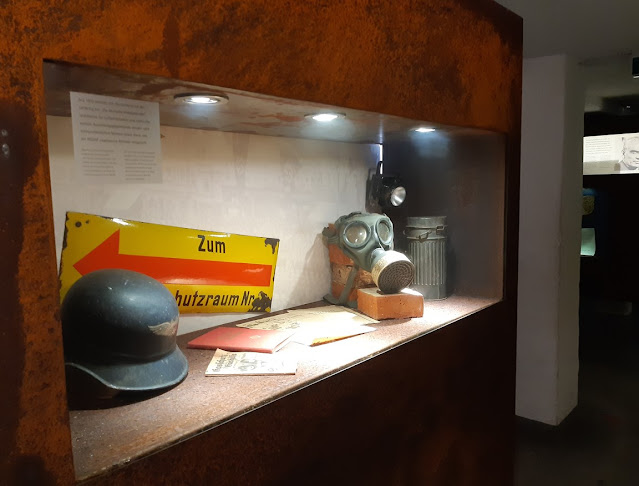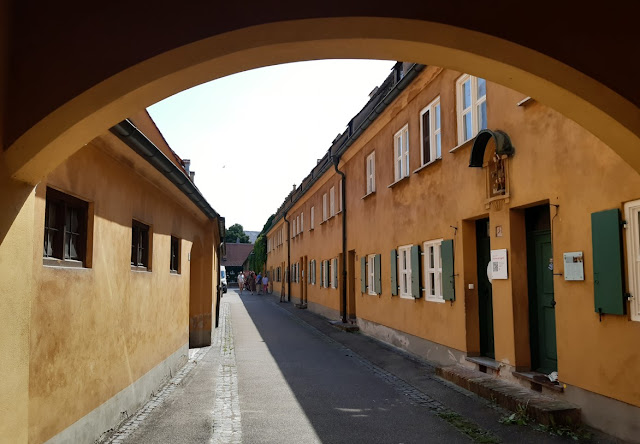25/7 Day 3: Visited Fuggerei, Took train to Eiskanal station to see Hochablass, a low dam and to take a dip. Night train to Ljubljana at 10.03pm (sitting). Reached Ljubljana the next day at 8.15am.
Costs
(1) Locker at Augsburg train station EUR5 (shared)
(2) Ticket to Fuggerei EUR8
Transport
(1) Return tram ticket to Eiskanal station, Augsburg City EUR7,60
(2) ÖBB Night train from Augsburg to Ljubljana EUR49,90
Food
(1) Breakfast at Stadtmarkt, Augsburg - Chocolate-filled croissant, cappucino and orange juice EUR11
(2) Fruit at Stadtmarkt - Cherries 500g (EUR15,80/kg) and seedless grapes 386g (EUR13,80/kg) for EUR13,23 (shared)
(3) Lunch at Fuggerei Biergarten - Sausages and radler EUR14,40
(1) Return tram ticket to Eiskanal station, Augsburg City EUR7,60
(2) ÖBB Night train from Augsburg to Ljubljana EUR49,90
Food
(1) Breakfast at Stadtmarkt, Augsburg - Chocolate-filled croissant, cappucino and orange juice EUR11
(2) Fruit at Stadtmarkt - Cherries 500g (EUR15,80/kg) and seedless grapes 386g (EUR13,80/kg) for EUR13,23 (shared)
(3) Lunch at Fuggerei Biergarten - Sausages and radler EUR14,40
(4) Beer at Hochablass Biergarten - EUR4,40
(5) Coffee - EUR4,20
(6) Dinner at Biergarten - Thuringer sausage EUR9,90 and radler EUR4,60
The Story


(5) Coffee - EUR4,20
(6) Dinner at Biergarten - Thuringer sausage EUR9,90 and radler EUR4,60
The Story
25072024 : We checked out from the hotel and walked to the train station to leave our luggage in the storage locker. There were not many storage lockers in the train station but we were able to find a locker.
First stop - City Market (Stadtmarkt) to look for breakfast. There were not many options for cafe.

We settled for an Italian cafe and had expensive breakfast of EUR11 which the owner set randomly as we asked if there was a breakfast set. This was not in the menu.
There was a fruit store beside the cafe and we bought cherries and green grapes (500g for EUR6,90 / SEK78). They are quite expensive compared to the grapes we buy at our grocery store in Stockholm. The green grapes are sold for SEK64,90 per kg. For cherries, there are no fresh cherries in Stockholm but there are frozen ones for SEK95,80 per kg. Those are definitely expensive cherries in Augsburg - EUR13,80/kg / SEK157,09)

We walked to town and walked into an Information Center when I saw a UNESCO sign on the building. I was very surprised to see a UNESCO sign as I was unaware that Augsburg is a UNESCO town.
One of the recommended places to see was Augsburg Rathaus (Town Hall). We did not go in. I read that there is a Golden Hall inside the building. None of us are very keen in town halls and museum unless they are really unique. The Perlachturm tower next to the town hall is closed for renovation.
Coincidentally, the town hall was in the same place as the Information Center. That is where I saw the UNESCO sign when I turned around. Inside the center, we were briefed on the water management system that earned Augsburg town its UNESCO title in 2019.
Five areas in Augsburg form a complex water management system with significant and preserved technical, architectural and industrial archaeological monuments from the late Middle Ages to the 20th century - the 22 objects. The nomination area is defined by the watercourses and canals as the most important parts of the water management system. The canals run from south to north over a distance of more than 20 kilometers, their total length is about 200 kilometers. They were built before 1276, when the Vorderer, Mittlerer and Hinterer Lech were first mentioned in writing, until the Eiskanal was converted into a canoe course in 1972. The diversions from the Lech and Wertach rivers, as well as the Singold and the springs in the city forest, also known as taps, supplied the water for these canals. Most of the canals still follow their original course and have not changed their position for centuries. Source from Wassersystem Augsburg
The staff showed us the water course in the animated map.
Then, we asked her if there was a place to take a dip in Augsburg. She recommended a place where Hochablass power plant is located. It is reachable by the tram and we decided to visit the place after lunch.
Next stop, we visited Fuggerei.
The Fuggerei is the oldest existing social housing complex in the world, a city within a city with 67 buildings and 142 residences as well as a church. Jakob Fugger founded in Fuggerei in his own and his brothers' names in 1521. Approximately 150 needy Augsburg citizens of the Catholic faith live here for an annual base rent of €0.88 and three daily prayers. Source from Fuggerei
The conditions to live there remain the same as they were 500 years ago: one must have lived at least two years in Augsburg, be of the Catholic faith and have become indigent without debt. The five gates are still locked every day at 10 PM. Source from Wikipedia
The Biergarten in the Fuggerei which we had our dinner the day before. We did not realise that it was in the Fuggerei.
The war bunk in the Fuggerei.

The neighbourhood is clean and well-managed. We visited the museums to get more information on the life in Fuggerei. In my opinion, I felt that the very cheap rent and good amenities provided in the Fuggerei does not motivate one to leave the neighbourhood and the locals here keep staying here for a long time.
We had our lunch in the Biergarten Fuggerei. I had german sausages with sauerkraut (fermented cabbage) while my travel companions had pork chop.
On the way to the tram station, we managed to take a quick look inside St. Anne Church where Jakob Fugger was buried.
Then, we took the tram to Eiskanal station to get our dip in the waters.
Of course, after the short but very hot walk, the first thing we had to do was drink beer.
Finally, a dip! The water was so warm. It was so lovely to take a dip.
Then, it was a tram ride back into town. Another beer and coffee (for me) break in town before dinner. I was so tired by now and I needed coffee, although beer would have been nice to cool me down. But I feel that I had been drinking too much radler. We had dinner at a random Biergarten where there were many locals. We got invited to share a table with some locals and they were surprised that we were here for a holiday as Augsburg is not a common tourist destination. It was fun talking to them (2 guys and 1 lady). The two guys were trying their best to speak in English but we understood them. One of the guys explained to us the history of the word 'radler'. Radler = cyclist in German and cyclists drink radler so that they can continue cycling. Radler is also an acceptable drink if one drives! Radler is a drink made of 50% beer and 50% soda. I always take radler.
Now, we walk to the train station to take the night train to Ljubljana. A month ago, we received an email that our sleeping car will be replaced by a sitting car as the sleeping car needs to be maintained. We were dreading to sleep sitting for 8 hours! There were 2 other travellers in the compartment and it was very cramped. I could not sleep well. It was hot, noisy, and no black-out curtains. In the email, we were told that we will be refunded 50% but no, we received back 25% only. What a dishonest train operator!





































No comments:
Post a Comment